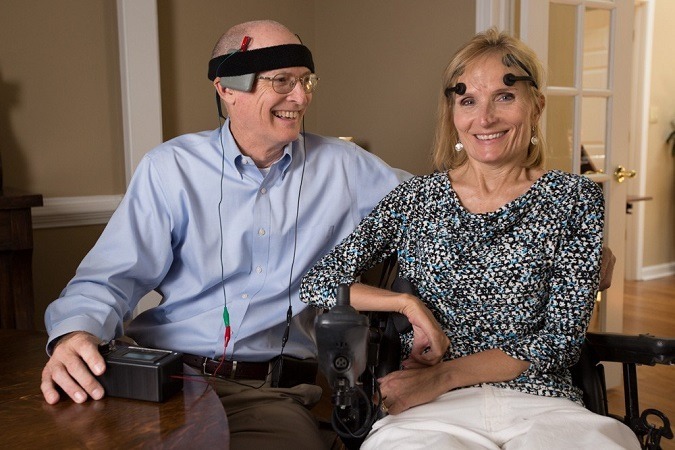Important insights on the growing home use of tDCS brain stimulation: older-than-expected users, positive self-reported results for treatment of depression but negative for self-enhancement, and a couple areas of concern (severe burns, frequency)

Dr. Brent Williams is wearing a homemade tDCS device while his wife Madge is sporting a commercial model. Photo by Kevin Liles/kevindliles.com
___
At the 2017 SharpBrains Virtual Summit last month, researcher and science writer Dr. Anna Wexler discussed some fascinating insights from her survey of 339 home (or “do-it-yourself”) users of tDCS (transcranial direct current stimulation) devices.
The survey results have just been published in the Journal of Cognitive Enhancement (details below), and provide a useful window into who purchases tDCS devices and why, how they use them and what results they see.
Here are some of the main findings:
(As you read them, keep in mind that the survey is not intended to be statistically representative of the user population at large — it was sent to people who had purchased a tDCS device from seven specific companies)
1. Profile of tDCS users: the majority live in the US (69%), are highly educated and older than expected (with a mean of 45.3‑years-old). In general they are early adopters of technology, with an affinity towards science.
2. Purpose: Nearly 75% of respondents reported using tDCS for cognitive enhancement (particularly to try and expand focus), 25% for restoration, and approximately 40% for treatment; as you can see many participants had several goals in mind.
3. Depression as significant indication: Notably, approximately one third of all participants utilize tDCS to self-treat depression.
4. Adherence to guidelines: Most users adhere to common scientific protocols regarding current level and session length BUT not regarding number of sessions: 8.4% of users self-administered 100+ sessions (far more frequently than in scientific studies).
5. Results: Interestingly, most who use tDCS for treatment self-report that they found the technology to be effective, whereas most who use it for non-treatment purposes (i.e., only enhancement and/or restoration) find it to be ineffective.
6. Dropout rate: Over 40% of those who purchase tDCS devices either quit using the device (mostly due to lack of efficacy) or have never used the device (mostly due to lack of guidance).
7. Side effects: 10 users reported serious skin burns.
The Study
Who Uses Direct-to-Consumer Brain Stimulation Products, and Why? A Study of Home Users of tDCS Devices (Journal of Cognitive Enhancement)
- From the study’s Discussion: Though the home use of non-invasive brain stimulation has been a subject of much discussion in the academic literature, there has been little empirical data on the practices and motivations of home users. This study provides the largest and most comprehensive survey to-date of users of consumer tDCS devices. Obtaining a deeper knowledge of what drives home users—to purchase and use a consumer tDCS device (or for many, to cease to use it)—has important implications, both for ongoing debates about the ethical implications of the home use of tDCS, as well as for discussions of the regulation of direct-to-consumer neurotechnology. Thus, the present study not only provides an empirical foundation on which to base policy recommendations, but also offers a concrete, empirical perspective on a debate that has too-often been one step removed from reality.
The Study in Context
- Study: Transcranial Direct Current Stimulation (tDCS) can reduce fatigue in patients with Multiple Sclerosis (MS)
- Consumers experiment with transcranial direct current stimulation (tDCS) with no regulatory oversight
- Neurotechnology and artificial intelligence (AI) can enhance our lives if it preserves our 1) privacy, 2) identity, 3) agency and 4) equality, researchers say
- Presentation by Anna Wexler and others at the 2017 SharpBrains Virtual Summit:


